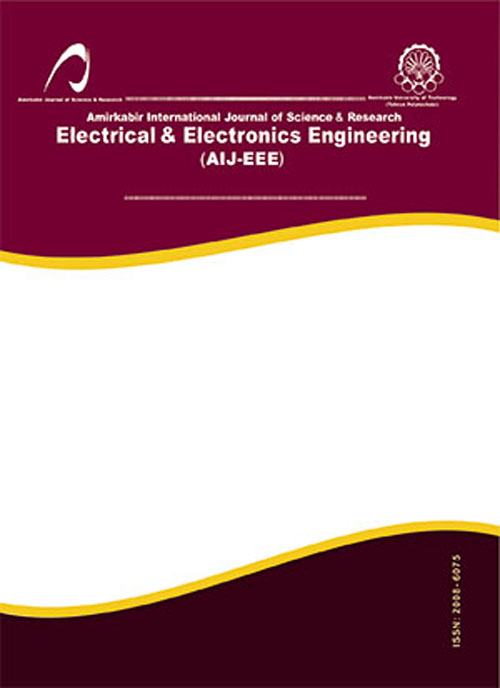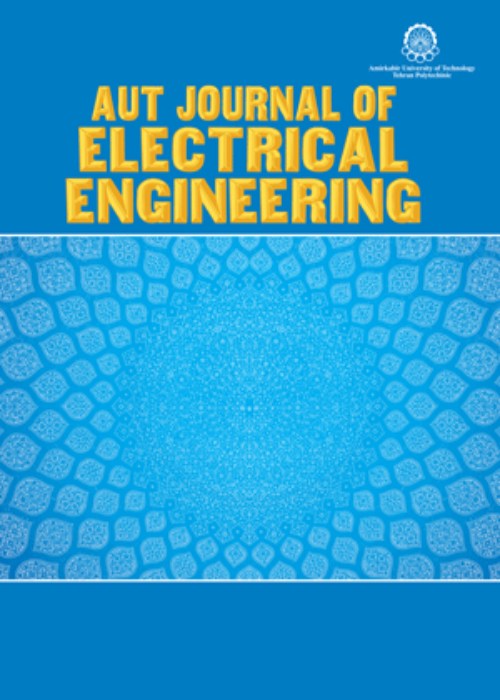فهرست مطالب

Amirkabir International Journal of Electrical & Electronics Engineering
Volume:48 Issue: 1, Winter - Spring 2016
- تاریخ انتشار: 1395/06/21
- تعداد عناوین: 6
-
-
Pages 1-10A compact and sharp-rejection ultra-wideband (UWB) microstrip band-pass filter (BPF) is developed using of left handed metamaterials realized by complementary split ring resonator (CSRR). Moreover, proposed structure consists of two doublets parallel coupling gaps at each side of a microstrip ring. In comparison with some other filters, this structure shows a significantly wider passband due to the introduction of a cross-coupling between the feed lines (input and output) which generate four pairs of attenuation poles in the passband.On top of that, using two CSRRs etched in the back substrate side,and series gap inside the microstrip ring leads to the addition of two extra transmission poles at the lower and upper edges of the filter.Consequently, a compact six-pole ultra-wide bandpass filter is designed which exhibits extremely sharp rejection skirts around the target passband.
The proposed filter has a passband covers3.4 to 10.15GHz andits measured 3dB fractional bandwidth is about 100%. Furthermore, rejection level better than 20 dB in upper stopband is extended to around 15.2 GHz both in simulation and measurement. Experimental verification is provided and good agreement has been found between simulation and measurement. To our knowledge, the size of proposed ultra-wideband filter is more compact in comparison with known similar filters.Keywords: Complementary split ring resonator (CSRR), ultra, wideband (UWB), bandpass filter(BPF), microstrip ring, doublets parallel coupling gaps -
Pages 11-17Electrostatic potential as well as the local volume charge density are computed for a macromolecule by solving the Poisson-Boltzmann equation (PBE) using the finite element method (FEM). As a verification, our numerical results for a one dimensional PBE, which corresponds to an infinite-length macromolecule, are compared with the existing analytical solution and good agreement is found. As a macromolecule has a rod-like shape with a finite length, a much more real case is considered, which leads to a two dimensional PBE. Furthermore, it is demonstrated that the potential and charge density decrease as the distance from the axis of the macromolecule increases. Moreover, it is concluded that the absolute value of the electrostatic field obtained from the nonlinear PBE subject to the boundary condition with a fixed charge differs from that of the linear PBE at fixed potential by an order of magnitude in the vicinity of the finite rod-like macromolecule. On the other hand, excellent agreement is observed between the electric fields calculated from the aforementioned equations at far distances.Keywords: Poisson, Boltzmann equation, finite element method, polyelectrolyte, reduced electrostatic potential
-
Pages 19-27Wireless communication is the major form of connection nowadays. In most cases it exploits the benefits of the spread spectrum techniques to overcome channel introduced corruptions like Doppler residual frequency, noise, interference and jamming. These techniques also enhance the security and quality of the link. Using long spreading pseudo-noise codes provides further security for the link though its acquisition is challenging. In this paper we propose Enhanced Dual Folding method for acquiring long codes in high Doppler scenarios. Two main criteria of an acquisition algorithm i.e. probability of detection and mean acquisition time is theoretically and numerically obtained for the proposed method. The proposed method's performance is simulated for two Doppler residual frequencies and is compared with a similar technique of long code acquisition which confirms the success of the proposed method in tolerating high Doppler in comparison with the similar technique. The simulation results agree well with the theoretical equations.Keywords: DSSS, Long PN, code Acquisition, Doppler, Folding, Zero padding
-
Pages 29-39Harmonics have become an important issue in modern power systems. The widespread penetration of non-linear loads to emerging power systems has turned power quality analysis into an important operation issue under both steady state and transient conditions. This paper employs an Extended Harmonic Domain (EHD) based framework for dynamic analysis of long term analysis over voltages during the transients caused by inrush currents while large power factor capacitors are located at transformer secondary side. In such cases, a combination of capacitor and inductive system impedance may lead to parallel resonance circuits of high impedance. As a significance of the developed method, it is fully frequency domain dependent solution technique which uses time dependent Fourier series, orthogonal bases and matrix operators as addressed in EHD. The proposed method has been successfully tested on several networks and the obtained results are compared to those of a time-domain software, followed by discussion on results.Keywords: Capacitor bank, Extended harmonic domain, Inrush current, Transformer, Windowed fast Fourier transform
-
Pages 41-51In this paper, Multi-Microgrids (MMG) are considered as future smart distribution grids, in which small scale energy resources (SSER) are main power generation units with small scales. Optimal operation of microgrids in defined intervals is carried out to achieve economic conditions in distribution systems. The defined operating problem is optimized using a heuristic algorithm considering uncertainties in loads and renewable energy resources (RERs). The probability density functions (PDFs) are used to encounter with the uncertainties. The total cost of the network is minimized by the algorithm. Then, each MG is evaluated from reliability point of view. Some new introduced reliability indices in the literature for MGs are used to evaluate the MG's reliability. In proposed structure, the MGs are in interconnected mode and there is power exchanging between MGs. The particle swarm optimization (PSO) algorithm is applied to optimal power dispatch and the obtained results are compared by Monte Carlo simulation (MCS) method.Keywords: Optimal Operation, Multi, Microgrids, Reliability Evaluation, Uncertainty
-
Pages 53-61The rapid scaling in modern CMOS technology has motivated the researchers to design new analog-to-digital converter (ADC) architectures that can properly work in lower supply voltage. An exchanging the data quantization procedure from the amplitude to the time domain, can be a promising alternative well adapt with the technology scaling. This paper is going to review the recent development in time-based noise-shaping ADCs, so-called as time-based sigma-delta modulators. Two of the most important architectures named as voltage-controlled oscillator (VCO) -based and time-to-digital (TDC) -based sigma-delta modulators (SDMs) are selected to be reviewed in this paper. The intrinsic advantages and limitations of the these structures are briefly explored. To confirm the effectiveness of the time-mode sigma-delta modulators, a TDC-based continuous-time sigma-delta modulator is proposed as an example and the related simulation results performed in MATLAB are illustrated. The simulation results show that the proposed modulator achieves a dynamic range of 67 dB over 30 MHz with the loop filter of order 2. The proposed TDC-based sigma-delta modulator shows the superiority of the time quantization approach in designing the wideband and less complex continuous-time SDMs.Keywords: Sigma, delta modulator, TDC, Time, based circuits, VCO


